
Fittingly, motorcycle-only parking fills the space just outside the doors of the building that houses the world’s greatest motorcycle collection.
During my recent trip to Memphis, I made a detour to northern Alabama to see one of those sights that anyone who’s truly fascinated with motorcycles just has to visit, at least once. The Barber Motorsports Park, on the eastern outskirts of Birmingham, Alabama, is a monument to what one person can do when he’s blessed with a metric ton of disposable income, a broad streak of perfectionism, and more than one human’s fair share of eccentricity. Fortunately for all of us who have the eccentricity without the burdensome quantities of disposable income, George Barber, who has the income, perfectionism and eccentricity, turned his attention to motorcycles. The result is by turns impressive, occasionally overwhelming, a bit confusing and surely unique.
George Barber, who inherited his family’s dairy distribution business and gave up auto racing to run it full-time, created a foundation and gave it millions of dollars of his own money to build the Barber Motorsports Park, in part because he wanted to do something to put his lifelong home of Birmingham on the map. He wanted to create the Augusta of motorsports facilities, and those who know enough about the world of golf to understand that allusion will make the connection from the moment they drive up the wide, smoothly paved, grass-bordered entrance road to the facility. Extras are everywhere on the grounds of the track, from the comfortable facilities to the flowers planted everywhere to the huge sculptures adding a whimsical touch to the rolling hills around the natural-terrain road course. Barber is a green oasis and a revelation for us North American race fans accustomed to road courses where the facilities are a few portable toilets ripening in the hot sun and the spectator areas are dusty slopes spiked with weeds nourished only by the occasional spilled beer.
While the race track is beautiful, I was not visiting on a race day. I was there to see the Barber Vintage Motorsports Museum, which houses quite possibly the world’s greatest collection of motorcycles, or at very least the greatest collection that’s easily accessible to the public.
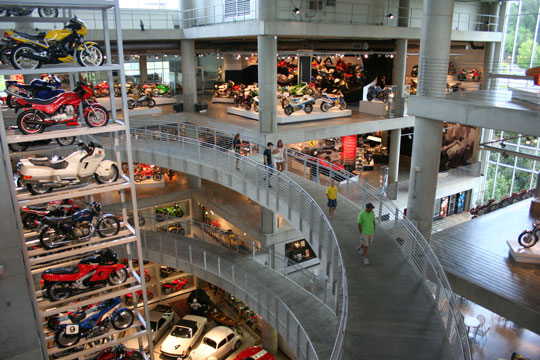
The five-story museum building would be impressive even if it were empty.
Though he had raced cars, not motorcycles, Barber realized he could put together a world-class collection of motorcycles more easily than a world’s-best collection of cars, and he was fascinated by the way the engineering of motorcycles was, for the most part, out there for everyone to see. By comparison, all the mechanical genius of even the greatest cars is generally hidden away beneath a shiny paint job.
He began collecting and restoring in 1989 and never looked back. Today, the collection is housed in a stunning five-story trackside building with a glass elevator in the center atrium, a spiral staircase, and broad views of the race track and manicured grounds.
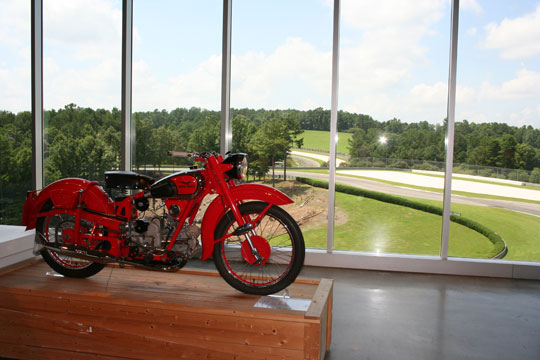
A 1949 Moto Guzzi Airone Turismo poses in front of the windows overlooking the race track.
What stuns most motorcycle fanatics when they visit the Barber museum is the sheer scale. And while there are about 600 motorcycles on display at any given time, that’s only half of the collection.
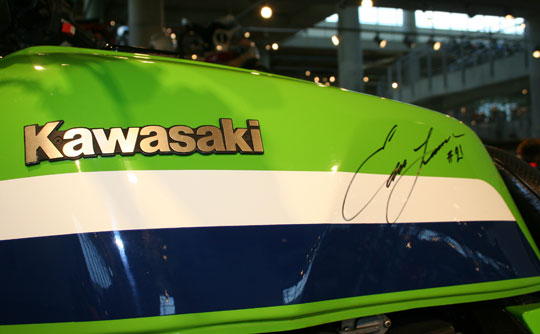
An Eddie Lawson autograph adorns one of his old Kawasaki Superbikes.
The other striking aspect of the collection George Barber amassed is how eclectic it is. One collector may want to buy up significant Italian sportbikes while another puts together a collection of race bikes with historic pedigrees, for example. George Barber wanted to buy absolutely everything. Everything.
As a result, even if you’re a knowledgeable motorcyclist, you’ll no doubt see motorcycles at the Barber museum that you’ve never seen before. Unless you’re a motorcycle historian, you’ll no doubt see motorcycles you’ve never even heard of.
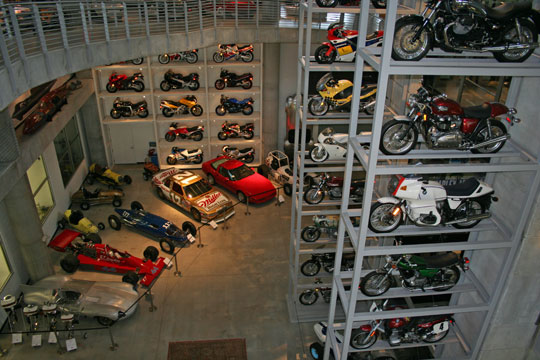
Motorcycles are stacked on racks, visible from a distance because of the open atrium design, making them look like Matchbox toys.
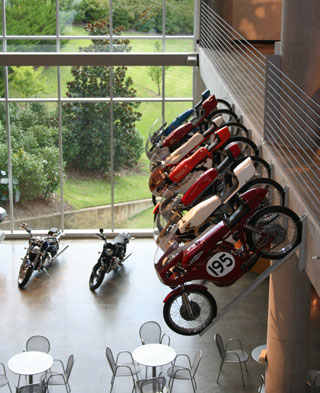
The bikes unlabeled and shoved off to an empty space at the Barber Museum would be enough to be the centerpieces of an exhibit at many lesser motorcycle museums, and that’s not to mention the half of the collection that doesn’t fit in the Barber museum.
While every hardcore motorcycle lover who visits the Barber museum talks about the scale of the collection and the impressive structure that houses it, there’s an aspect of the Barber museum that I don’t think I’ve seen mentioned in the many words written about it. Although the museum says that part of its mission is “to preserve the history of motorcycles from an international aspect,” it dispenses with many of the educational efforts other museums focus on. Most of the motorcycles on display have a small plaque providing information about the machine, both its place in history and its specifications. But some don’t even have that label.
In part to meet the requirements of their tax-exempt status, museums go to lengths to provide an educational component to their exhibits. Curators often grapple with issues such as putting together an exhibit that presents the historical context, as well as the bikes, and that can be enjoyed at various levels, both by the expert who can spot a poorly done restoration from across the room and the busload of sixth-graders on a field trip. So exhibits tend to focus on specific topics and provide various layers of information so visitors can dig in or skim by.
There’s no such organization or context at the Barber museum. Instead, with a few exceptions, motorcycles seem to be scattered purely at random throughout the building. For example, in one area I saw a stock 2009 Yamaha V-Max sitting next to a 1944 Harley-Davidson Model U and a 1995 Aprilia Moto 6.5, a styling exercise by French designer Philippe Starck. No category smaller than “motorcycle” could include three such machines with nothing in common, but there they were, poised side by side. In many ways, the Barber Vintage Motorsports Museum really is a collection more than a museum.
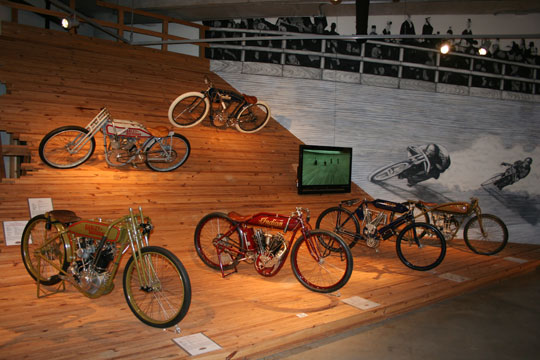
This display of board track racers is the closest thing to a typical museum exhibit at the Barber museum.
Is this lack of detail and historical context a shortcoming? I doubt more than a few of the many visitors to the Barber museum care.
And anyway, I can’t say the Barber museum didn’t provide an educational function for me during my visit because I definitely learned something new. I learned that there’s a lot more discretionary income to be made than I ever thought possible by selling ice cream and those little cartons of milk to schoolkids. Just ask George Barber.
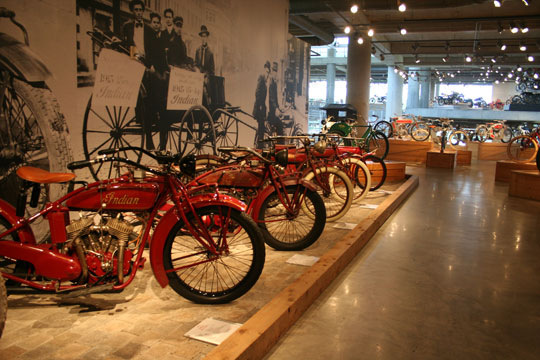
A row of old Indians.
